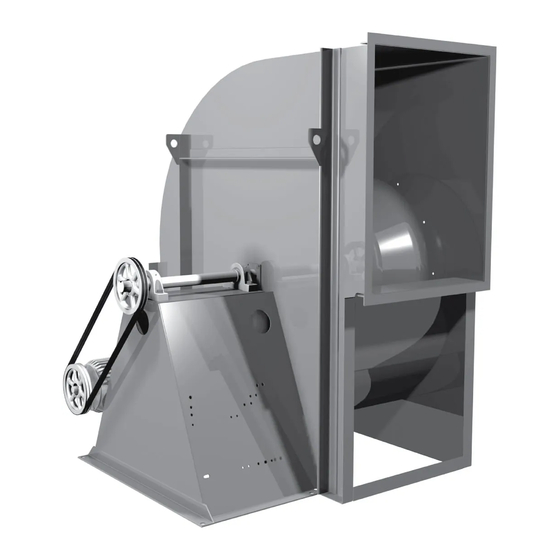COOK CF SWSI Panduan Pemasangan, Pengoperasian, dan Pemeliharaan - Halaman 8
Jelajahi secara online atau unduh pdf Panduan Pemasangan, Pengoperasian, dan Pemeliharaan untuk Blower COOK CF SWSI. COOK CF SWSI 12 halaman. Centrifugal blowers
Juga untuk COOK CF SWSI: Panduan Pemasangan, Pengoperasian, dan Pemeliharaan (17 halaman)

8.
Place the bearings into position making sure they are not
on a worn section of the shaft. Tapping the inner ring face
with a soft driver may be required.
NOTICE! Do not hammer the bearing housing.
9.
The outer ring of the bearing is spherical and swivels
in the housing to compensate for misalignment. Secure
hold-down bolts, but do not fully tighten.
10. Align the setscrews on the bearings and tighten one set-
screw on each bearing.
11. Rotate the shaft to allow the bearing outer rings to find
their center of free movement.
12. Install the wheel on the shaft. Install the inlet cone in its
original location. And adjust bearing position and inlet
cone to center the wheel in the inlet cone.
13. Tighten hold-down bolts to proper torque.
14. Turn the shaft by hand. Resistance should be the same
as it was before hold-down bolts were fully tightened.
15. Tighten bearing setscrews to specified torque. Refer to
the Recommended Torque chart.
16. Re-install the pulley and adjust the belt tension.
17. Test run and retighten all setscrews and bolts; trim bal-
ance as necessary (.0785 in/sec max.).
After 24 hours of operation, retighten the setscrews to the ap-
propriate torque. This assures full locking of the inner race to
the shaft. Make sure the socket key or driver is in good con-
dition with no rounded corners. The key should be fully en-
gaged in the setscrew and held squarely to prevent rounding
out of the setscrew socket when applying maximum torque.
For Arrangement 3:
Bearings should be replaced individually for each side
of fan.
1.
Loosen and remove belts.
2.
If replacing drive side bearing, mark location of pulley
and then remove.
3.
Mark bearing location on bearing support and loosen
bearing hold down bolts.
4.
Support shaft to remove weight from bearing.
5.
Remove anti-corrosion coating from the shaft with a suit-
able de-greaser.
6.
Remove bearing from the shaft using a bearing puller. If
a bearing puller is not available, tap on the bearing with a
wood block and hammer to remove it.
7.
Smooth and clean the shaft and bearing bore thoroughly.
8.
Place the bearing into position making sure it is not on
a worn section of the shaft. Tapping the inner ring face
with a soft driver may be required. Do not hammer on the
housing.
9.
The outer ring of the bearing is spherical and swivels
in the housing to compensate for misalignment. Secure
hold-down bolts, but do not fully tighten.
10. Align setscrews on the bearings and tighten one set-
screw on bearing.
11. Rotate the shaft to allow the bearing outer ring to find its
center of free movement.
12. Tighten hold-down bolts to proper torque. Refer to Rec-
ommended Torque chart.
13. Turn the shaft by hand. Resistance should be the same
as it was before hold-down bolts were fully tightened.
14. Tighten bearing setscrews to specified torque.
15. Re-install the pulley if required.
16. Repeat process for opposite bearing.
CA/CF/CP IO&M
17. Adjust the belt tension.
18. Test run and retighten all setscrews and bolts; trim bal-
ance as necessary (.0785 in/sec max.).
After 24 hours of operation, retighten the setscrews to the ap-
propriate torque. This assures full locking of the inner race to
the shaft. Make sure the socket key or driver is in good con-
dition with no rounded corners. The key should be fully en-
gaged in the setscrew and held squarely to prevent rounding
out of the setscrew socket when applying maximum torque.
Troubleshooting
Problem and Potential Cause
Low Capacity or Pressure:
• Incorrect direction of rotation. Make sure the fan rotates
in same direction as the arrows on the motor or belt drive
assembly
• Poor fan inlet conditions. There should be a straight clear
duct at the inlet
• Improper wheel alignment
Excessive Vibration and Noise:
• Damaged or unbalanced wheel
• Belts too loose; worn or oily belts
• Speed too high
• Incorrect direction of rotation. Make sure the fan rotates
in same direction as the arrows on the motor or belt drive
assembly
• Bearings need lubrication or replacement
• Fan surge or incorrect inlet or outlet conditions
Overheated Motor:
• Motor improperly wired
• Incorrect direction of rotation. Make sure the fan rotates
in same direction as the arrows on the motor or belt drive
assembly
• Cooling air diverted or blocked
• Improper inlet clearance
• Incorrect fan RPMs
• Incorrect voltage
Overheated Bearings:
• Improper bearing lubrication
• Excessive belt tension
8
B51181-002
